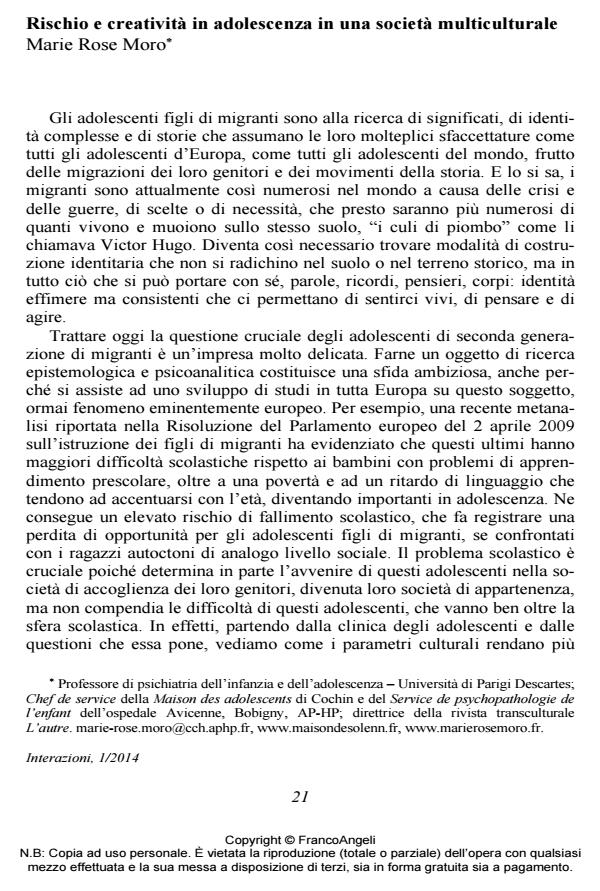Risk and creativity in adolescence within a multicultural society
Journal title INTERAZIONI
Author/s Marie Rose Moro
Publishing Year 2014 Issue 2014/1 Language Italian
Pages 11 P. 21-31 File size 48 KB
DOI 10.3280/INT2014-001003
DOI is like a bar code for intellectual property: to have more infomation
click here
Below, you can see the article first page
If you want to buy this article in PDF format, you can do it, following the instructions to buy download credits

FrancoAngeli is member of Publishers International Linking Association, Inc (PILA), a not-for-profit association which run the CrossRef service enabling links to and from online scholarly content.
Adolescents in our multicultural society are broad-based. Indeed, being born and raised in a different country from their parents brings the adolescents into negotiations, into blending of cultures and identity arrangements thus allowing the multitude of parentage and affiliation processes to interact harmoniously. This weakness is linked to transcultural risk, but is also a source of creativity as long as this cultural blending, proper to all those who engage in the task of transforming the notion of otherness into new constructs of self and new relations to others, is acknowledged. This must be taken into account to understand and treat adolescents, wherever they come from.
Keywords: "Second generation" adolescents, children of migrants, otherness, identity, creativity.
- AA.VV. (2004). L’autre, n. 14 – «Bébés étranges, bébés sublimes». Grenoble: La Pensée sauvage.
- Aulagnier P. (1989). Se construire un passé, Journal de Psychanalyse de l’enfant, 7: 119-220.
- Baubet T., Moro M.R. (2009). Psychothérapie transculturelle. Paris: Masson.
- Ben Jelloun T. (2006). Partir, Roman. Paris: Gallimard.
- Cyrulnik B. (1999). Un merveilleux malheur. Paris: Odile Jacob.
- Debray R., Gauchet M. (2005). Cherchons République désespérément, Le Nouvel Observateur, 15-21 décembre 2005: 42-4.
- Devereux G. (1970). Essais d’ethnopsychiatrie générale. Paris: Gallimard.
- Devereux G. (1972). Ethnopsychanalyse complémentariste. Paris: Flammarion (réédition 1985).
- Garcia Lorca F. (2008). Jeu et théorie du duende. Paris: Allia.
- Laplanche J., Pontalis J.B. (1967). Dictionnaire de la psychanalyse. Paris: PUF.
- Mac Dougall J. (1978). Plaidoyer pour une certaine anormalité. Paris: Gallimard Moro M.R. (2007). Aimer ses enfants ici et ailleurs. Histoires transculturelles. Paris: Odile Jacob.
- Moro M.R. (2010). Les adolescents expliqués à leurs parents. Paris: Bayard.
- Moro M.R. (2010). Nos enfants, demain. Pour une société multiculturelle. Paris: Odile Jacob.
- Moro M.R. (2012). Les enfants de l’immigration, une chance pour l’école. Entretien avec Denis et Joana Perron. Paris: Bayard.
- Moro M.R., Moro I. et al. (2004). Avicenne l’andalouse. Devenir psychothérapeute en situation transculturelle. Grenoble: La Pensée sauvage.
- Nathan T. (1986). La folie des autres. Traité d’ethnopsychiatrie clinique. Paris: Dunod.
- Nathan T. (1987). La fonction psychique du trauma, Nouvelle revue d’ethnopsychiatrie, 8. Résolution du Parlement européen du 2 avril 2009 sur l’éducation des enfants de migrants.
Marie Rose Moro, Rischio e creatività in adolescenza in una società multiculturale in "INTERAZIONI" 1/2014, pp 21-31, DOI: 10.3280/INT2014-001003